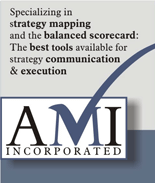
 |
 |

An effective risk management program can no longer be seen as a 'nice-to-have'. There are simply too many threats today. Yet a recent survey of public and private company directors by the National Association of Corporate directors in the United States suggests that less than 30% of directors believe their boards are highly effective in risk management. Similarly, 36% of the directors who responded to a 2002 survey conducted by McKinsey and Company indicated they did not understand fully the major risks their organizations face. The scary fact is that most organizations still find themselves scrambling to determine the resources and know-how to deal effectively with risk.
The balanced scorecard has been touted as a tool that can help any organization to better measure and manage progress toward its chosen strategy. Since the management of risk is often instrumental in achieving organization objectives, it makes sense to consider how risk management may be incorporated into the balanced scorecard to help with the identity, measurement, management and reporting of key risks. Since the balanced scorecard is an integrating framework, it lends itself well to initiatives such as risk management.
Risk management and the balanced scorecard
There are several ways that companies can deal with risk. One way is a four-step process for effectively identifying, measuring, managing, and reporting risks:
- Brainstorming a comprehensive list of risks facing the organization;
- Preparing the risk assessment chart for each risk type (see diagram below);
- Completing the risk report card (see diagram below);
- Entering results into the balanced scorecard to gauge actual overall performance (*an optional step).
The Three Levels of Results
By following this three-step process, the reader can see how information is tiered into three levels. First, managers can get a good overall sense for how effective its risk management program is compared to expectations (from the balanced scorecard). Second, the risk report card provides another level of detail that can be used to put a spotlight on areas needing further attention. And third, for each risk an assessment can be made as to just how much risk is being assumed (in terms of probability and consequence), and what is being done about it. Figure 3 below provides a conceptual illustration of this.
Potential Benefits
This approach to risk management can be useful in many ways, and a host of potential benefits can result. A few are discussed here. First, it allows adopters to formalize a risk management program in an inexpensive way, using existing software packages and resources. Second, it helps to bring focus and clarity to the organization on what risk areas are in most need of improvement. And finally, by putting a spotlight on the most urgent risk areas, it can help direct management toward a strong and sustainable plan of action
CLICK HERE IF YOU WOULD LIKE TO VIEW OUR WORKSHOP INFORMATION
HOME | SERVICES | TESTIMONIALS | PUBLICATIONS | STRATEGY MAPPING | THE BALANCED SCORECARD | RISK MANAGEMENT | ABOUT US | CONTACT US
Property of AMI Incorporation, 2006 |
Designed by ellips design + consulting